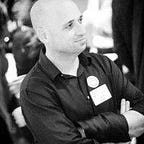A long time ago (summer of 2006) in a country far, far away (Israel) I joined a large and amazing company (@SAP). I joined a global team of visionary product managers who’s purpose at SAP was to research emerging technologies and deepen SAP’s knowledge of current and future users for the company’s solutions. It was the peak of the WEB 2.0 era and ‘Innovation’ was a seriously overused buzzword…and so was another one, ‘mashup’.
I’ll spare you the Google definition of the word as it is rather straightforward; in the realm of ‘digital technology’ it meant fusion of technologies, capabilities, data-sources and interfaces in order to cater an innovative experience that empowers the user. For the next ~4 years I heard and used ‘mashup’ in countless meetings & emails until it started to die out. It’s not that humanity gave up on mashing-up things, we’re still applying it today in most solutions we release, the term just took a backseat behind ‘mobile’, ‘big data’, ‘AI/ML/DL’, ‘SaaS’ and a few other millennial-era newbies.
A couple of months ago (‘couple’ is more then two in ‘American-English’) as Corona stopped being a beer and took over our lives and livelihood, I found myself pondering about the new reality we’re adjusting to and the human-centered solutions that are not fine-tuned to meet the needs of the new global reality. I LOVE solving problems using design & technology so I picked a use-case and turned it into a case-study — Hospital Admission.
Let’s imagine that a random great big company takes on the impossible topic of Hospital-Admission User Flow and not only improving it but doing so with a COVID-19 perspective of ‘Quick & little margin for error’.
In “normal” days, a patient walks into an urgent-care facility and follows a certain flow which involves people, medical-services and front/back-end technology and interfaces.
This flow takes between 30 min to over 2 hours with lots of time to check the vitals, patient records, charge the credit card and run all sorts of lab tests; ‘Abundance of Time ‘ = ‘Generic Process’ + ‘Less Margin for Error’.
Enters the COVID-19! Patients storm the hospital, some may be infected while others are not, hospital staff is overworked, all systems provide data (patient identity and records , hospital operations, billing…) but not in a tactical way that allows staff and sr. staff members to provide swift care and indicate which patient is under less or more risk — it’s a nightmare!
Technologies mashup, catered through innovative product design is the key to solution; what needs to be done is:
- Re-evaluate and modify the patient-ambition flow
- Implement new technologies which cut on procedural-time
- Promote backend-technologies that support steady data-flow and maintain data-accuracy
- Provide UI input and output through technologies that connect digital, physical and voice for data-entry and in-context-data.
- All product solutions (front-end & back-end, hospital-ops & staff-patient hand operated) should update and pull from the same data source/s with a smart data management in place (MDM, data-clusters etc.) to align across all systems, facilities and patient-relevant decisions.
When patients walk-in, a ‘Tier-1’ medical staff member will conduct a preliminary interview and vitals check as well as identifying the patient and pulling his/her file.
The staff member will use an Android based PDA to scan the patient’s ID or insurance card using ‘Google Lens’ technology. This feature exists on any Google phone and allows you to scan printed or screen-displayed text turning it into a copyable (I think it’s a word in English…) text on your device.
The staff-member PDA communicates the patient-details to the system through an SAP MDM system that validates the patient’s identity including his/her coverage billing details AND pulls the patient’s records in the context of COVID-19 and his/her personal pre-existing conditions as well as ‘risk group’ etc. The evaluating staff member needs to be quick in transitioning the patient and cannot lose time over computer typing — having a set of Google-glasses on allows the medical staff to dictate the diagnosis into the system using speech-to-text technology mashup with Replicant.ai. Using SAP MDM speech-to-text and patient records are updated and presented in a COVID-19 contextual UI which promotes relevant data for the medical staff. The UI allows a staff member to “skip the lines” of process and page-a-doctor/order-a-test/book-a-room — whatever is needed to accurately and personally take care of the patient in a timely manner.
The COVIDE-19 positive/negative part of the flow (‘Tier-2’ staff) uses the data collected and existing-data to further evaluate the patients through COVID-19 lab tests. all data entered is cleaned & validates and shared amongst the medical teams and their devices. ‘Tier-3' team members are a dedicated team which evaluates the severity of COVIDE-19 positive patients and assign the course of action, per patient.
Further patient tests and diagnostic conversation using the same technology mashup across all PDA’s allows the medical staff to assign the patient to the right ‘severity-level’ group and run quick hospital-operational tasks, facility and staff assignments straight from the PDA’s UI.
We just witnessed the awesome power of technology + design saving lives through ‘mashup’! This type of solution requires several dedicated teams and certainly some effort and possible partnerships between companies…maybe even a startup or two. You might say this takes time, research, design, coding etc. …ok, I hear ya’, but considering the fact that an average vaccine development time takes about 10 to 12 years and we have tens of pharmaceutical companies aiming to hit the finish-line in less then 2 years I believe we, the digital software and physicals products designers and engineers, cam make some life-saving-magic happen in a shorter amount of time.
Mashup is the secret sauce, the world is waiting for you and me to make the best salad/pasta to make our lives better, faster!
